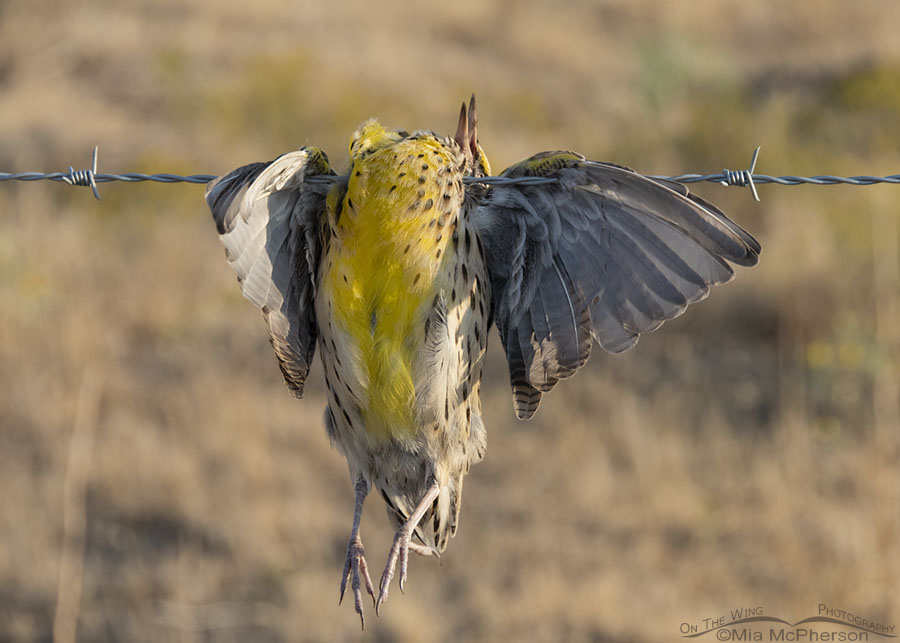I love what I do 99.9% of the time but being out in the field also exposes me to sights I don’t like to see which is birds and animals hung up on fences.
 Deceased Western Meadowlark hung up on a barbed wire fence – Nikon D810, f7.1, 1/1250, ISO 800, Nikkor 18-200mm at 105mm, handheld, natural light
Deceased Western Meadowlark hung up on a barbed wire fence – Nikon D810, f7.1, 1/1250, ISO 800, Nikkor 18-200mm at 105mm, handheld, natural light
I’ve come across more birds and animals hung up on barbed wire fences than I have wanted to see. There have been a few times that I have been able to rescue live birds caught on fences that would have died a slow painful death without intervention including an adult Barn Owl in Montana and a fledgling Short-eared Owl here in Utah.
Both of those rescued owls lived. The Barn Owl was rehabbed and released at Red Rock Lakes National Wildlife Refuge which was not far from where it was rescued. The young Short-eared Owl had extensive damage to his patagialis and wasn’t releasable. After rehab the young Short-eared Owl was handed over to HawkWatch International, named Galileo, and he is currently was an education bird there. (Galileo died in 2023)
I’ve come across other birds and animals that unfortunately died slowly and painfully after becoming hung up on barbed wire death traps. Some I have photographed and some I just couldn’t bring myself to raise my lens. I’ve seen bats, deer, pronghorn, Burrowing Owls, Short-eared Owls, grouse and other birds and animals that had died because they became entangled and perished due to fences.
Last month the first photos I took on a trip out to the West Desert were images that I felt I needed to take to document the death of a Western Meadowlark that had gotten entangled on a single barb of a fence. I saw the meadowlark hanging from the fence and thought I might be able to rescue it. The Western Meadowlark was deceased and I was too late to save it.
The birds and animals don’t always see the fences before they become entangled or before they strike the fences at high speeds. Barbed wire is probably the deadliest fencing material for birds and wildlife but other fencing materials can be deadly too. There are wildlife friendly options for fencing and oh how I wish that more ranchers and landowners would use them which would save the lives of countless birds and animals.
Over the past month I thought about whether I wanted to share images and tell the story of this Western Meadowlark that lost its life because of a barbed wire death trap and finally decided that the story needed to be told.
Who knows, a rancher or a landowner that came across a dead bird or animal hung up on a fence might find this post and realize that there are wildlife friendly options for fencing and act on it.
I hope so. We can all spread the word about wildlife friendly fencing options.
Mia
Click here to see more of my Western Meadowlark photos plus facts and information about this species.





Thank you for posting– was not aware of this problem. I hope those with barbed wire fencing will switch to something else that doesn’t kill wildlife.
Great images of the owls you saved!
An unsettling pic that presents a stark reminder of our influence on the environment. Thanks for this post Mia.
Sad!
Grief for a life lost too soon.
Patty calls barbed wire devils wire. And I agree.
How I wish that less destructive fencing was much more widely used.
Awareness is always good in the birding community and thanks for linking to the safe fencing article. Interesting read.
Thanks for sharing
Thank you for this, Mia. I am wondering what your thoughts are on any benefits to barbed-wire fencing? I have never encountered a scene such as this that I can recall, but am sure it happens. On the other hand, I’ve seen thousands of sparrows, bluebirds, meadowlarks, and other birds using fencing as perches. This has got to be a clear benefit to them. What do you think of the pros and cons?
It is ugly. It is upsetting. But I think it all comes down to money, unfortunately.